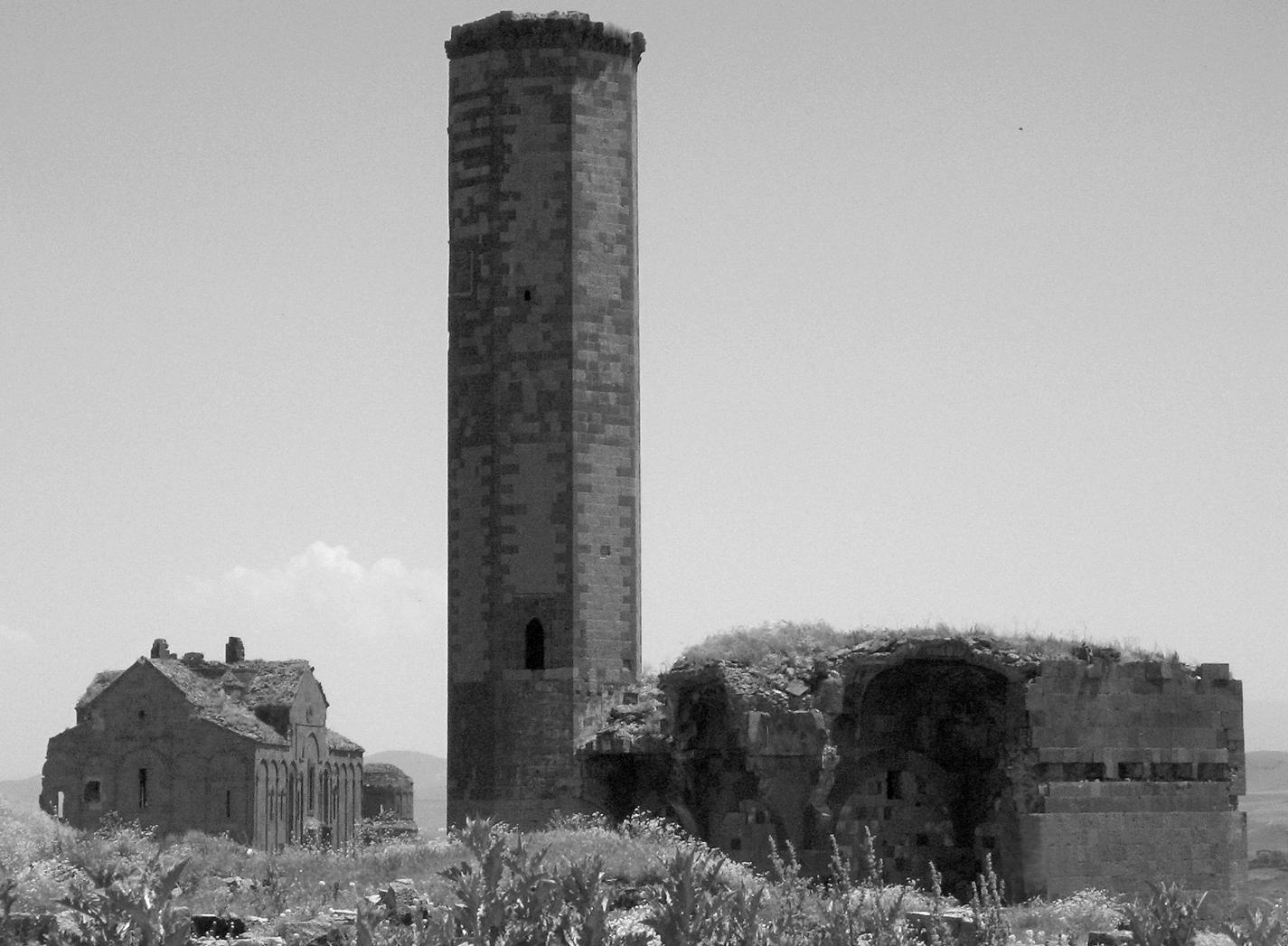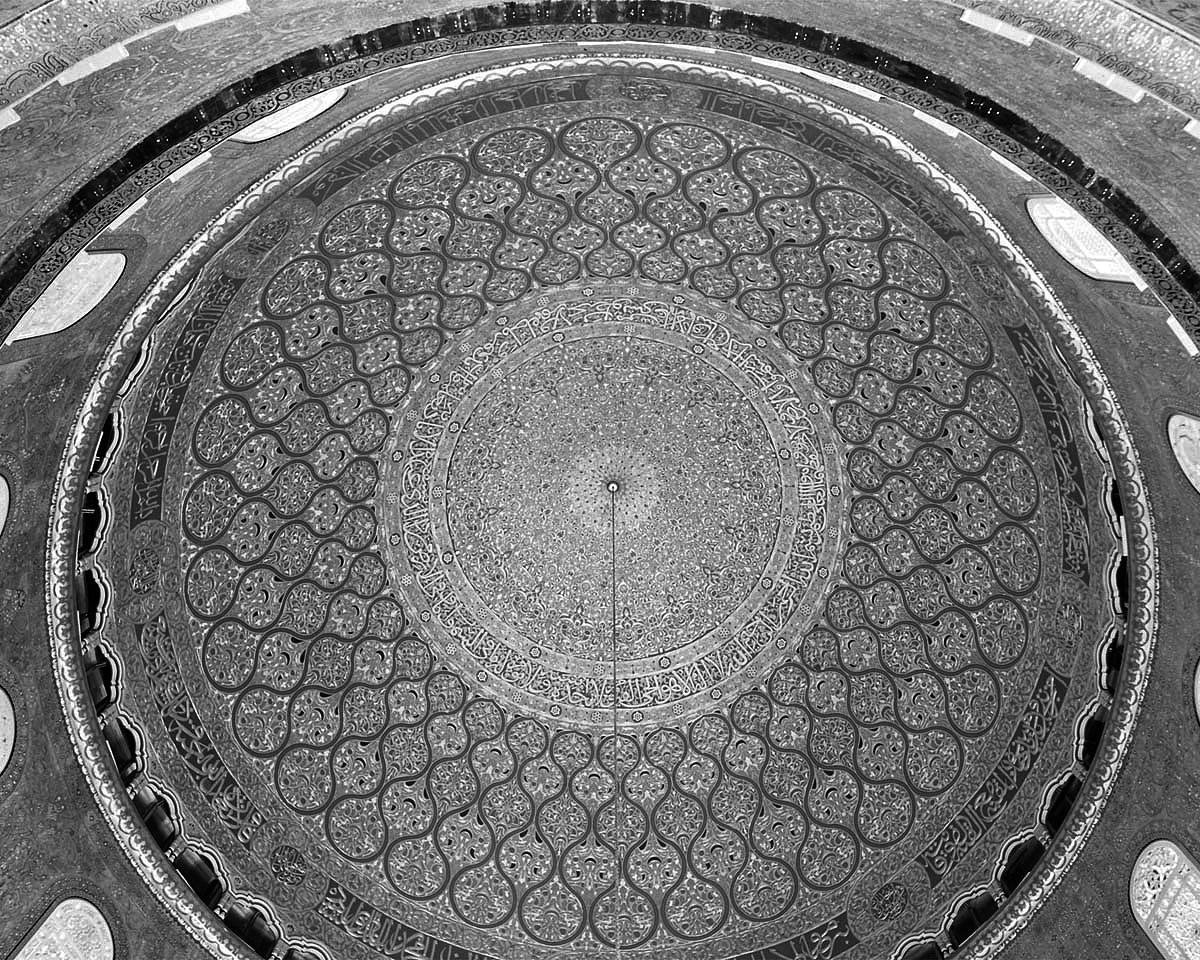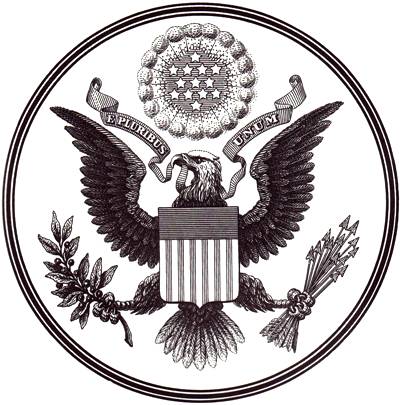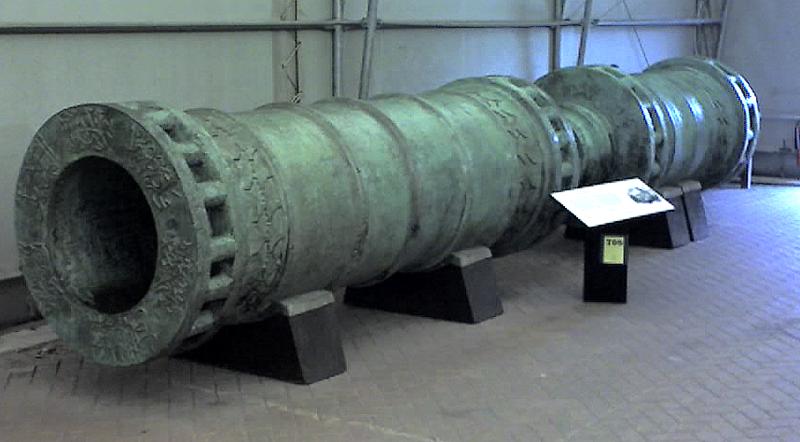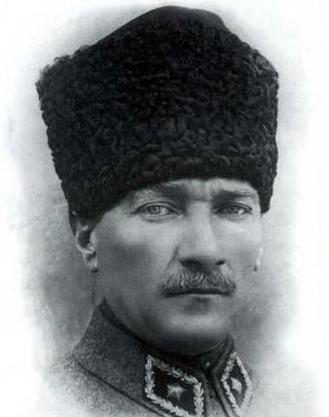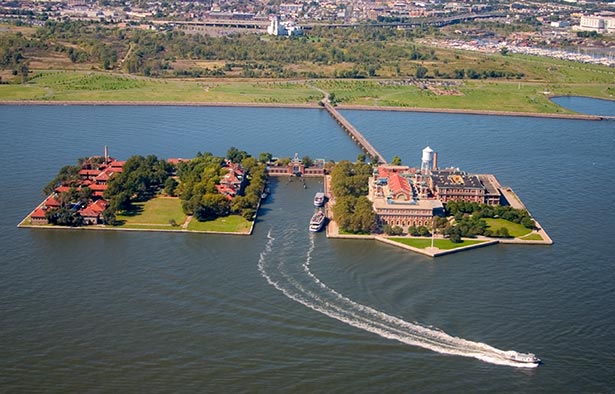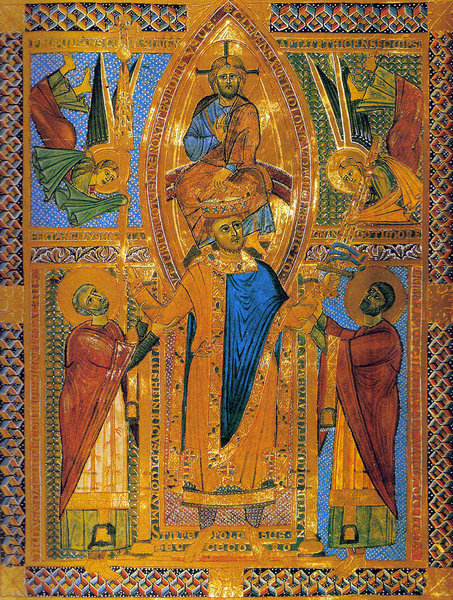Brothers and sisters, the Holy Spirit has guided you here. This is the only place in the world with the answer to the most enigmatic time-period passages in the Bible:
- the 666 of
Revelation 13:18 - the 1290 Days
of Daniel 12:11 - the 1335 Days of
Daniel 12:12 - the 42 Months of Revelation 13:5
- the 70 Weeks
of Daniel 9:24 - the 1260 Days of
Revelation 12:6 - the 5 Months of
Revelation 9:5 - the 1000 Years of
Revelation 20:2 - the 10 Days of
Revelation 2:10 - the 601 Years
of Genesis 8:13 - the 1 Hour of
Revelation 18:10 - the 3.5 Days of
Revelation 11:9
These and other Bible verses all point to Jesus' glorious return to earth in 25 years.
Appendix IV. Notable Years in God’s Dealings with Mankind
-
3976 BC
Creation of the Universe (Genesis 2:1–2; Section 91)
-
3975 BC
Fall of Man through Eve and Adam’s sin (Genesis 3:6). Promise of
Christ’s reign through Eve (Genesis 3:15; Section 83)
-
3740 BC
Purification of the pre–Christian Church through calling upon the name of the
Lord (Genesis 4:26; Section 70)
-
2988 BC
Promise of Christ’s reign through Enoch being taken to Heaven without
dying (Genesis 5:24; Hebrews 11:5; Sections 67, 70)
-
2919 BC
Noah is born (Genesis 5:28–29; Section 47)
-
2419 BC
Purification of the pre–Christian Church though Noah’s ark
project (Genesis 6:13–14; Section 70)
-
2319 BC
Floodwaters unleashed (Genesis 7:11; Section 47)
-
2318 BC
Noah leaves ark and worships God in the post–flood world
(Genesis 8:20; Section 47)
-
2250 BC
The earliest known library established in Ebla, Syria (Section 101)
-
2144 BC
Languages are confused at the Tower of Babel
(Genesis 11:7–9; Section 102)
-
1908 BC Abraham leaves his home in Ur of Chaldea and begins his journey to Canaan (Genesis
12:1; Section 43). Christ’s reign is promised by God through Abrahamic Covenant
(Genesis 12:3; Section 70)
-
1892 BC Abraham buries his father in Haran (Genesis 11:32) and arrives in Canaan (Genesis 12:4–5). Marks the beginning of the 430 years of the Children of Promise in Egypt and Canaan (Exodus 12:40–41; Section 40)
-
1883 BC
God makes a covenant with Abraham (Genesis 15:18; Section 44)
-
1862 BC
Persecution of Isaac by Ishmael (Genesis 21:9). Marks the beginning
of the four hundred years of oppression in Egypt and Canaan (Genesis
15:13; Section 40)
-
1846 BC
Abraham offers Isaac on the Temple Mount of the future Jerusalem
(Genesis 22:10; Section 44)
-
1808 BC
Jacob (the future Israel) is born to Isaac and Rebekah
(Genesis 25:26; Section 44)
-
1736 BC
Jacob flees Esau’s wrath. Lives with his Uncle Laban
(Genesis 29:13–14; Section 31)
-
1716 BC
Jacob returns to Canaan (Genesis 31:17–18). God renames him Israel
because he does not ignore God, but contends with Him
(Genesis 32:28; Section 31)
-
1715 BC
Judah marries a Canaanite woman (Genesis 38:2; Section 53)
-
1543 BC
Moses is born (Exodus 2:2; Section 43)
-
1541 BC
Moses is weaned and given to Pharaoh’s daughter
(Exodus 2:10; Section 43)
-
1501 BC
Moses kills an Egyptian slave master, and flees to Midian
(Exodus 2:12–15; Section 43)
-
1463 BC
Moses called by God at the Burning Bush (Genesis 3:2–6) and
returns to Egypt (Exodus 7:6–7; Section 43)
-
1462 BC Pharaoh tries to destroy Moses and his flock of Israel’s children (Exodus 14:9). Purification of the pre–Christian Church through Exodus from Egypt via the Red Sea (Exodus 14:21–22; Section 70). Ten Commandments given by God and recorded on parchment by Moses (Exodus 20:1–17; Section 45)
-
1423 BC
Moses looks upon the Promised Land of Canaan (Deuteronomy 34:4) and
then dies (Deuteronomy 34:5; Section 43)
-
1422 BC
Joshua leads the children of Israel into the Promised Land
(Joshua 3:17; Section 43)
-
1076 BC
King Tiglath-Pileser, founder of the Assyrian Empire, reaches the
zenith of his power and then dies (Section 42)
-
1014 BC
Promise of Christ’s reign through line of David (2 Samuel 7:11–16;
Section 70)
-
868 BC
Elijah taken to heaven without dying (2 Kings 2:11; Section 67)
-
767 BC
Jonah warns the Ninevites of impending judgment (Jonah 3:4). They
repent and are saved (Jonah 3:5; Section 42)
-
721 BC
Kingdom of Israel conquered by Assyrians. Ten tribes carried into
oblivion (2 Kings 17:6; Section 42)
-
712 BC
Isaiah prophesies that the True Israel will be called by a new name
(i.e., ‘Christian’; Isaiah 56:5; Isaiah 62:2; Isaiah 65:15; fulfilled
in Acts 11:26; Section 56)
-
704 BC
Assyrian king taunts God and King Hezekiah of Judah
(Isaiah 37:10–11; Section 63)
-
701 BC
King of Assyria tries to destroy Judah, but God smites his army
(2 Kings 19:35; Section 63)
-
612 BC
Nineveh falls to the Babylonians and is destroyed (Isaiah 10:12;
Section 42)
-
605 BC
Prophet Daniel deported to Babylon (Daniel 1:3,6; Section 46)
-
597 BC Jerusalem conquered by the army of King Nebuchadnezzar. Treasures of the First Temple plundered. Judah forced to pay tribute to Babylon (2 Chronicles 36:10; 2 Kings 24:13; Section 83)
-
592 BC
The presence of the Lord departs from the First Temple
(Ezekiel 10:4,18), and daily sacrifices stop (referred to
in Daniel 12:11; Section 46
-
588 BC
Jews revolt against Babylonian domination
-
586 BC
Jerusalem is re-conquered by the army of Babylonian King
Nebuchadnezzar, and the First Temple is destroyed (2 Kings 25:8–10).
King of Judah blinded and his heirs killed (2 Kings 25:7). High
Priest is killed and the Jews are exiled (Jeremiah 52:24–27; Section 41)
-
539 BC
Babylonians defeated by Medo–Persians (Daniel 5:30–31; Section 19).
Jews are allowed to return to Jerusalem and begin rebuilding their
temple (Ezra 5:13). Timeline for First Coming of the Messiah given
to the Prophet Daniel by the Angel Gabriel (Daniel 9:20–27; Section 26–27)
-
521 BC
The Jews’ enemies around Jerusalem become alarmed by their
determination to return and reestablish the city (Ezra 4:1–5;
5:3–4; Section 44)
-
516 BC The Jews dedicate the Second Temple in Jerusalem (Ezra 6:16; foretold in Jeremiah 25:11–12; Section 44). Purification of pre–Christian Church through exilic restoration (Ezra 6:20–21; Section 70)
-
485 BC
Xerxes becomes king of Medo–Persian Empire (Esther 1:1–2; Section 44)
-
479 BC
Esther becomes Xerxes’ queen (Esther 2:17; Section 44)
-
474 BC King Xerxes gives order to extirpate all the Jewish believers throughout his empire (Esther 3:11). He later reverses the order at the request of Queen Esther, and the Jews triumph over their enemies at Purim (Esther 9:1–2; Section 44)
-
473 BC
Mordecai is exalted to Prime Minister of the Medo–Persian Empire
by the order of King Xerxes (Esther 10:3; Section 44)
-
458 BC
Call put forth from Medo–Persian King Artaxerxes for the walls,
fortifications, and streets of Jerusalem to be rebuilt (Ezra 8:36;
Section 26)
-
445 BC
Enemies of the Jews tear down their recent work on the walls of
Jerusalem (Nehemiah 1:3; Ezra 4:7–23; Section 26)
-
432 BC
Nehemiah decries the Jews’ intermarriage with enemies of Israel
(Nehemiah 13:23–25; Section 53)
-
409 BC
Rebuilding of Jerusalem is complete despite opposition (foretold in
Daniel 9:25). Enemies of Jews are vexed (Nehemiah 6:15–16; Sections
26–27)
-
334 BC
Greeks defeat Medo–Persians (foretold in Daniel 7:6; Section 19)
-
168 BC Seleucid ruler desecrates the Second Temple by sacrificing a pig to Zeus upon the altar (foretold in Daniel 11:31). He massacres many Jews in Jerusalem (foretold in Daniel 11:33; Section 34)
-
63 BC
Roman Republic annexes Judea
-
27 BC
Roman Empire founded (foretold in Daniel 7:7; Section 19)
-
6 BC
God becomes incarnate in the womb of the blessed virgin Mary by
the overshadowing of the Holy Spirit (Luke 1:35; Sections 23, 39)
-
AD 26 Jesus Christ is baptized in the River Jordan; the Father, the Holy Spirit, and John the Baptist testify of His Lordship (Matthew 3:13–17). Christ’s ministry begins, and He is rejected in Nazareth (Luke 4:29; Sections 23). He begins to “confirm a covenant with many” for seven years (Daniel 9:27; Sections 26–27)
-
AD 28
Jesus teaches that Jonah’s time inside the fish would be analogous to
His own time inside the tomb (Luke 11:29–30; Section 42)
-
AD 30 Jesus Christ is crucified, buried, and resurrected (Section 83). With this he puts an end to Jewish temple sacrifices and offerings (Daniel 9:27; Sections 26–27), and conquers sin, death, and every power of the devil. Proof of His New Body is shown for forty days. Beginning of the ‘End Times’—which lasts until the second Coming. Promise of Christ’s reign through the Ascension (Acts 1:11; Section 70)
-
AD 33
The Deacon Stephen becomes first Christian martyr (Acts 7:54–60).
This ends the seven years during which the Messiah was to “confirm
a covenant with many” (Daniel 9:27; Sections 26–27). Christ’s early
Church is dispersed from Jerusalem and begins to spread the Gospel
(Acts 8:1,4)
-
AD 43 The term ‘Christian’ is first used to describe believers in Antioch (Acts 11:26; Section 56). This is the new name of the True Israel, and replaced the old name of ‘Jew’ (foretold in Isaiah 56:5; Isaiah 62:2; Isaiah 65:15)
-
AD 51
The Apostle Paul debates Epicurean and Stoic philosophers in Athens,
Greece (Section 104)
-
AD 53
The Apostle Paul writes that before the Second Coming of
Christ, a ‘falling away’ from the faith (i.e., Anti–Chalcedonianism
and Anti–Filioqueanism) must occur, and the ‘Son of Perdition’
(i.e., Ali) must first be revealed (2 Thessalonians 2:1–4; Section 15)
-
AD 70 Because of the Jews’ rejection of the Messiah, Jerusalem is conquered and the Second Temple is destroyed by the Legions of Roman General Titus (foretold in Daniel 9:26). The Jews within Jerusalem are slaughtered, but the Judean Christians heeded prophesy and previously fled to the Transjordanian mountains (Daniel 11:41; Luke 21:20–22; Section 26)
-
AD 96
The Apostle John completes the writing of the Bible with the Book
of Revelation (Section 45)
-
AD 286
Emperor Diocletian splits the Roman Empire into eastern and western
halves to make it more manageable (Section 19)
-
AD 300
Final and most severe Roman persecution of the Church initiated by
Emperor Diocletian (Section 71)
-
AD 301
Countries of Armenia and San Marino are Christianized (Section 71)
-
AD 313
Edict of Milan issued by Emperor Constantine, removing penalties
for professing Christians (Section 61)
-
AD 325
First ecumenical council held in Nicaea. Arianism is overwhelmingly
rejected by the Christian Church. Nicene Creed drafted (Section 61)
-
AD 336
Construction begun on the Church of the Holy Sepulchre (Section 71).
The heretic Arius dies on a public toilet in Constantinople the day
before he is to be served communion (Section 61)
-
AD 337
Emperor Constantine dies (Section 61)
-
AD 381
Second ecumenical council held in Constantinople; Nicene Creed
finalized with addition of the Holy Spirit clause (Section 61)
-
AD 405
Mesrop Mashdots invents the Armenian alphabet for the purpose of
spreading Christianity. The Bible is soon translated into the new
Armenian script (Section 67)
-
AD 428
Heresy of Nestorianism emerges (Section 62)
-
AD 431
Third ecumenical council held in Ephesus denounces Nestorianism.
Assyrian Church of the East splits from the rest of Christianity
(Section 62)
-
AD 449 Pope Leo the Great writes the Tome of Leo which correctly argues that Jesus Christ was one undivided Person with two separate natures. Foundational document of Chalcedonianism (Section 67)
-
AD 451 Christian Armenians fail to receive military assistance from the Eastern Roman Empire and lose the Battle of Avarayr to Zoroastrian Persians (Section 62). Fourth ecumenical council held in Chalcedon. Monophysitism repudiated by the Christian Church (Section 62). Armenians Apostolics, Egyptian Copts, and Syriac Orthodox do not accept the findings of the council and eventually unite with each other under the heretical Oriental Orthodox Communion (Section 67)
-
AD 476 Western Roman Empire ends with the deposition of Romulus Augustus. From this time until AD 1453, the Eastern Roman Empire represents the extant part of the Roman Empire (Daniel 7:7; Section 19)
-
AD 553
Fifth ecumenical council held in Constantinople denounces Monophysitism
a second time (Section 63)
-
AD 570
Muhammad is born (Section 18)
-
AD 589 Goths of Spain converted from Arianism to Christianity. Council of Toledo is held in which the Nicene Creed is unofficially amended to include the Filioque. Marks the completion of the writing of the three Ecumenical Creeds (with the Filioque). Over half the Christian Church rejects the orthodox faith of the three Ecumenical Creeds (with Filioque) and ‘fall away’ (foretold in 2 Thessalonians 2:3; Section 69)
-
AD 599
Son of Perdition, Ali, is born (2 Thessalonians 2:3–4); six years
later he is brought into Muhammad’s home (Sections 18, 22)
-
AD 602
Emperor Maurice and his heirs are killed by mutinous troops. Phocas
proclaims himself Eastern Roman emperor (Section 63)
-
AD 610
Heraclius enters Constantinople without resistance, kills Phocas,
and becomes Eastern Roman emperor by acclamation (Section 63)
-
AD 614
Sassanid Persians conquer Jerusalem after stiff resistance. Slaughter
of Christians in the city. Persians desecrate Church of the Holy
Sepulchre, and steal the relic of the True Cross (Section 63)
-
AD 620 Maximus the Confessor flees to Carthage because of the Sassanid Persian encroachment into Asia Minor. There he meets the Eastern Roman general, Peter of Numidia, and gains his trust (Section 64)
-
AD 621
Heraclius invades behind Persian lines and begins re-conquest of
Eastern Roman Empire territory (Section 63)
-
AD 622
Hijra or flight of Muhammad from Mecca to Medina. First year of
the Muslim calendar (Section 29)
-
AD 624
Muhammad wins the Battle of Badr—the turning point for his eventual
conquest of Mecca. Ali is commended for bravery and granted Muhammad’s
daughter’s hand in marriage (Section 22)
-
AD 628
Heraclius completes re-conquest of Eastern Roman Empire territory
from Sassanid Persians. Sassanid Emperor killed by his son, and the
Persian Empire falls into chaos (Section 63)
-
AD 629
Emperor Heraclius carries the relic of the True Cross into Jerusalem
on his back. It is the second and last time a reigning Roman Emperor
visits Jerusalem (Section 64)
-
AD 630 Heraclius forces the Monothelite heresy upon the Eastern Roman Empire. Muhammad captures Mecca. Muawiyah accepts Muhammad’s religious views in order to save his life, and quickly advances in position (Section 22)
-
AD 632 Heraclius orders Jews of Eastern Roman Empire to be forcibly baptized. Earthquake in Palestine. Sword-shaped comet travels south to north over Levant. Muhammad dies; Abu Bakr becomes first Caliph of the Arab Empire. Maximus the Confessor writes of desert barbarians (i.e., Arab Bedouins) laying waste to parts of the southern Levant (Section 64)
-
AD 634 Maximus the Confessor raises alarms about Heraclius’ Monothelite heresy. A synod is convoked in Cyprus to debate the emperor’s christological formulation (Section 64). Abu Bakr dies and Umar becomes second Caliph of the Arab Empire
-
AD 635
Nestorians reach China with their heretical Christology on the eve of
the Arab conquest of their homeland in Babylon and Persia (Section 62)
-
AD 636
Battle of Yarmuk in which the army of the Eastern Roman Empire is
crushed by the emergent Arab Empire (Section 65)
-
AD 637 Jerusalem surrendered to the Arabs. Caliph Umar and future-Caliph Ali are present for the handover. Patriarch Sophronius correctly identifies the new masters of the holy city, saying, “The abomination of desolation is in the holy place” (a quote from Daniel 12:11; Section 22)
-
AD 638
Arabs conquer Palestine. Introduction of the Hijra lunar calendar which
starts with the flight of Muhammad from Mecca to Medina in AD 622
(Daniel 7:25; Section 29)
-
AD 641
Emperor Heraclius dies. Monophysite Copts of Egypt celebrate
(Section 65)
-
AD 644
Umar dies, and Uthman becomes third Caliph of the Arab Empire
-
AD 649
Lateran council in Rome denounces Monothelitism (Section 65)
-
AD 653
Pope Martin kidnapped from Rome and brought to Constantinople for
trial (Section 65)
-
AD 654
A Jewish admirer of Ali begins to preach that Ali was the only
legitimate successor of Muhammad. He travels west from Iraq spreading
his message (Section 22)
-
AD 655
Pope Martin tortured, exiled, and killed for opposing Monothelitism
(Section 65)
-
AD 656
Uthman pressured to resign as Caliph. He refuses and is killed by a
mob. Ali becomes fourth caliph of the Arab Empire, and allows Uthman’s
assassins to evade justice (Section 22)
-
AD 657
Muawiyah suspects Ali in the death of his uncle, Uthman. He seizes
control of Egypt. Ali is challenged during the first Islamic civil war
at the Battle of Siffin (Section 22)
-
AD 661 Formulation of separate Arab religion inside the head of Caliph Ali (2 Thessalonians 2:3). He cries out, “By the Lord of the Kaaba, I have succeeded!” as he is struck by a poison-tipped spear. Ali’s rival, Muawiyah, becomes fifth caliph of the Arab Empire. He is hostile to Ali’s dream of a new world religion, and ambivalent toward Muhammad’s legacy. The Shi’a and Sunni branches of Islam are born—six hundred and sixty-six years after Christ’s incarnation (Revelation 13:18; Section 22)
-
AD 662
Maximus the Confessor brought to trial, mutilated, exiled, and killed
for opposing Monothelitism (Section 65)
-
AD 670
Ali’s first son, Hasan, (who had renounced any claim to the Caliphate
and retired to Medina) is poisoned by one of his wives at the instigation
of Caliph Muawiyah (Section 22)
-
AD 680 Sixth ecumenical council held in Constantinople denounces Monothelitism and affirms Chalcedonianism for a third time (Section 65). Muawiyah dies and his son Yazid becomes the sixth caliph of the Arab Empire. Ali’s second son, Husayn, tries to take over the Arab Empire with seventy-one followers. They are massacred at the Battle of Karbala (Section 22)
-
AD 683
Caliph Yazid dies unexpectedly, creating a struggle for control of the
Arab Empire (Section 20)
-
AD 685 After a year and a half power struggle, Abd al-Malik becomes seventh major caliph of the seventh century. These represent the seven heads of the Antichrist Beast (Revelation 13:1). Abd al-Malik spends the next seven years consolidating power within the Arab Empire (Section 22). Heraclius’ great-great grandson, Justinian II, becomes Eastern Roman Emperor (Section 65)
-
AD 692 Caliph al-Malik secures full control of the Arab Empire by putting down rebellions in Iraq and Mecca, and by defeating the Eastern Roman Empire at the Battle of Sebastopolis. He introduces the first Islamic monetary system, begins construction on the Dome of the Rock, and dictates its Antichrist inscriptions. The Christians of Jerusalem revolt, are crushed, and part of the city is destroyed (Section 22). Caliph al-Malik resurrects Ali’s dream of a new world religion by deleting the cross from coinage, and imprinting “Muhammad is the Messenger of God.” Beginning of the Cult of Muhammad—six hundred and sixty-six years after Christ’s baptism (Revelation 13:18; Section 23)
-
AD 695
Justinian II is deposed as Emperor and his nose is cut off. Beginning
of ten year period of political instability in Eastern Roman Empire
(Section 65)
-
AD 696
Mid–point of Dome of the Rock construction. Gold coin issued that
denies the Trinity, the Incarnation, and that calls for the new
Anti–Trinitarian religion to prevail over all other religions. Marks
the institutionalization of the Antichrist Islamic religion—six hundred
and sixty-six years after Christ’s resurrection from the dead
(Revelation 13:18; Section 23)
-
AD 699 Likely year that the Dome of the Rock is completed and gilded—seven years after the beginning of construction. Islamic monetary system is finalized. Marks the setting up of the ‘abomination that causes desolation’ (Daniel 12:11), and the sending forth of Islamic orthodoxy from Jerusalem—six hundred and sixty-six years after the Christian Church went forth from Jerusalem (Revelation 13:18; Section 23)
-
AD 705
Justinian II regains the throne of the Eastern Roman Empire and
institutes purges (Section 65). Seventh major caliph, al-Malik, dies
-
AD 711
Heraclian Dynasty in Eastern Roman Empire ends when Justinian II and
his heir are killed (Section 65)
-
AD 728 Synod of Manzikert [incorrectly] denounces the Tome of Leo, and entrenches the Armenian Apostolic Church and the Syriac Orthodox Church in the Monophysite heresy. This permanently unites them with the Egyptian Copts, but divides them from the Greeks and Romans, as well as the Georgian Orthodox Church, which rejects Monophysitism and becomes Chalcedonian at this time (Section 67)
-
AD 732 Charles ‘The Hammer’ Martel decisively defeats a superior number of Muslims at the Battle of Tours, and halts the Muslim incursion into Western Europe through Iberia—sparing Rome from the Antichrist Beast of Islam (Revelation 12:6; foretold in Matthew 16:18; Section 69)
-
~ AD 760
Qur’an is finalized—nearly every early draft is destroyed to cover-up
the fact that it is an edited work (Section 82)
-
AD 787 Seventh ecumenical council condemns the christological heresy of Iconoclasm. The council affirms that the adoration of images of Christ are edifying in that it reminds worshipers of His dual nature in the miraculous Incarnation. Celebrated as the ‘Triumph of Orthodoxy’ by the Eastern Orthodox Church
-
AD 800
Charlemagne re-establishes a semblance of the Western Roman Empire
by founding the Holy Roman Empire (Section 69)
-
AD 868
Twelfth Imam, Muhammad al-Mahdi, is born. Believed by the Shi’a to be
the promised redeemer of their faith (Section 73)
-
AD 873
Muhammad al-Mahdi is said by the Shi’a to have gone into occultation
until the end of the world (Section 73)
-
AD 966
Church of the Holy Sepulchre is partially burned by a Muslim mob
(Section 71)
-
AD 995
Emperor Basil II re-conquers most of Syria from the Arabs
(Section 65). The Eastern Roman Empire holds the territory until
the Seljuk invasion
-
AD 1009
Caliph al-Hakim completely destroys the Church of the Holy Sepulchre,
and desecrates the tomb of Christ. The high-water mark for Islam
(Section 71)
-
AD 1014 The Filioque is recited for the first time in Rome at the coronation of the Holy Roman Emperor Henry II (Section 69). The western Church confesses the orthodox Christian faith, and the Millennium begins. Devil is bound for one thousand years (Revelation 20:2), and the saints in Heaven reign with Christ. The Antichrist Beast of Islam begins to decline (Section 71). Promise of Christ’s reign in three proper Ecumenical Creeds (Revelation 20:4; Section 70)
-
AD 1016
Earthquake in Jerusalem partially destroys the Dome of the Rock.
Providence’s thousand year warning of the coming Tribulation
(Revelation 20:7; Section 71)
-
AD 1048
The Caliph allows a chapel to be built over the Holy Sepulchre, but
pilgrimage is restricted (Section 71)
-
AD 1054
The Great Schism in which the Eastern Orthodox broke off from the
orthodox Christian faith—largely over the inclusion of the Filioque
in the Nicene Creed (Section 69)
-
AD 1055
The Oghuz Turks conquer Baghdad and the Seljuk Empire begins.
Represents first horn of Land Beast (Revelation 13:11; Section 71)
-
AD 1071
Eastern Roman Empire loses the Battle of Manzikert to a smaller Seljuk
force. Seljuk Empire overruns Anatolia, and permanently establishes
Islam there (Section 71)
-
AD 1072
First Seljuk mosque in Anatolia is constructed in the Armenian capital
of Ani. It prominently displays the Turks’ introduction of the minaret
for the Antichrist’s call to prayer (Revelation 13:15; Section 25)
-
AD 1095
After an appeal for help from the Eastern Roman Emperor, the Pope
calls for the first Crusade (Section 71)
-
AD 1099
Jerusalem is conquered by the Crusaders under Godfrey of Bouillon.
Maronite Christians of Lebanon abandon Monothelitism and reestablish
communion with Rome (Section 71)
-
AD 1187
Crusaders surrender Jerusalem to Kurdish Muslim, Saladin. Treaty
established that allows Christian pilgrimage (Section 71)
-
AD 1299
Ottoman Empire begins. Represents second horn of land beast (Revelation
13:11; Section 25)
-
AD 1451
Johannes Gutenberg begins printing pages of the Latin Vulgate Bible on
movable type (Section 70)
-
AD 1453
Constantinople falls to the Ottoman Turks—last remnant of the Roman
Empire is extinguished by the ‘little horn’ of the Caliphate
(Daniel 7:8; Sections 19, 41)
-
AD 1455
Gutenberg sells the first copy of the printed Latin Vulgate Bible
(Section 70)
-
AD 1492 King and Queen of Spain are victorious against the Muslim stronghold of Granada, and finally expel the Moors from the Iberian peninsula (Matthew 16:18). Columbus discovers America—a vast wilderness that has been reserved by God to harbor the Christian Church (Revelation 12:14; Section 71)
-
AD 1494
Shah Ismail comes to power in northwest Iran. Claims to be the Mahdi
or ‘Hidden Imam.’ Forces Iranians to convert to Shi’aism (Section 73)
-
AD 1514
Battle of Chaldiran in which Iranians are slaughtered by Turkish
firearms despite their faith in the Mahdi (Section 73)
-
AD 1517
Martin Luther launches the Reformation of the Church by posting
ninety-five theses (Section 70)
-
AD 1523
Martin Luther introduces a new order of Christian worship (Section 41)
-
AD 1529
Ottoman Turks advance on Vienna (Section 71)
-
AD 1530
Augsburg Confession presented to Holy Roman Emperor Charles V.
Purification of Christian Church through Reformation
(Revelation 12:6; Section 70)
-
AD 1532
Ottoman Turks advance on Vienna for a second time. Holy Roman Emperor,
Charles V, enters into a temporary peace with the Schmalkald League of
Lutheran princes and, defeats the Turks (Revelation 12:6; foretold in
Matthew 16:18; Section 71)
-
AD 1552
Chaldean Catholic Church comes under Vatican oversight—lessening the
numbers and influence of the Nestorian church (Section 67)
-
AD 1563
End of the eighteen year long Council of Trent. Roman Catholics, in
their ‘Counter Reformation,’ officially and finally rejecting Luther’s
Reformation of the Church (Section 81)
-
AD 1571
Ottoman fleet obliterated by the fleet of the Holy League at the Battle
of Lepanto. Last major naval battle involving rowing vessels (Matthew
16:18; Section 71)
-
AD 1620
Pilgrim Fathers form a permanent colony in Plymouth, Massachusetts,
and claim the vast wilderness of the future United States for Christ
(Revelation 12:14; Section 59)
-
AD 1803
The United States, in its first act of war since becoming a sovereign
nation, bombards and blockades the Muslim Barbary Coast pirates
(Section 71)
-
AD 1817 King Friedrich Wilhelm III forces the Lutheran and Reformed churches of Potsdam into, the ‘Evangelical Christian Church,’ and mandates an open communion policy. Beginning of the Prussian Union (Section 59)
-
AD 1827
Turkish fleet defeated at the Battle of Navarino in the War of Greek
Independence. Last major naval battle involving sailing vessels
(Section 71)
-
AD 1832
Dispensational Premillennialism introduced by John Darby (Section 27)
-
AD 1834
Heinrich Heine issues a prophetic warning about de-Christianization
in Germany (Section 59)
-
AD 1838
‘Old Lutherans’ begin leaving Prussia for the wilderness of the New
World in protest of the Prussian Union (Revelation 12:14; Section 59)
-
AD 1867 Czar Alexander II sells Alaska to the United States, preserving all of the wilderness of North and South America for Chalcedonian and Filioquean Christian believers (Revelation 12:14; Section 37)
-
AD 1886
Karl Benz patents the automobile (Revelation 9:1–10; Section 49)
-
AD 1909 Scofield Reference Bible published, making Dispensationalism the standard eschatology within the American Evangelical movement—especially in Baptist, Pentecostal, and non–denominational churches (Section 27)
-
AD 1911
The first-ever aerial bomb is dropped upon Ottoman troops in Libya
during the Italo–Turkish War. Beginning of eleven years of war for
Turkey (Section 71)
-
AD 1915 Beginning of the genocides against the Armenian, Greek, and Syriac Christians by the Ottoman Turks (Zechariah 7:13–14). The final, horrific, gasp of the Caliphate, as it tries to impose Islam on eastern Christians (Sections 36, 67)
-
AD 1920
Bolsheviks emerge victorious in the Russian Civil War. Turkish
parliament meets for the first time
-
AD 1921 President Warren Harding signs a joint congressional resolution that formally ends the First World War for the United States. Arab lands are colonized by the United Kingdom and France. Turkish parliament meets for the first time and ratifies a new constitution; Caliphate loses all power (Revelation 11:2, 12:6, 13:5; Section 30). Great immigration wave of the Christian Church to the United States symbolically ends with the Emergency Quota Act (Revelation 12:14; Section 31)
-
AD 1922 War in Heaven (Revelation 12:7). The one hundredth caliph, Sultan Mehmed VI deposed. Sultanate and Ottoman Empire are ended. Smyrna is burned under the command of General Kemal Ataturk, and Greeks are expelled from Asia Minor. End of large-scale massacre of Christians in Anatolia (Sections 30, 36). Union of Soviet Socialist Republics is established (Revelation 12:13; Sections 13, 31)
-
AD 1923
Republic of Turkey declared; Ataturk becomes its first president
(Section 30)
-
AD 1924
Republic of Turkey officially abolishes Caliphate and exiles all
members of the Ottoman dynasty (Section 30)
-
AD 1949
Sayyid Qutb inspired to become the intellectual father of modern
Islamic fundamentalism at a Mainline Protestant church dance
(Revelation 17:13; Section 86)
-
AD 1959
Patriarch of Alexandria grants Ethiopian Monophysites their own
patriarchy (Section 62)
-
AD 1960
Unofficial start of the Culture Wars in the United States
(Revelation 12:15; Section 34)
-
AD 1964
On Good Friday a 9.2 earthquake strikes off Alaska. Providence’s
seventy year warning of the end of the world (Section 100)
-
AD 1970
Secular Alawites come to power in Syria, aligning this Sunni-majority
country with the interests of the Shi’a majorities in Iraq and Iran
(Section 68)
-
AD 1972 Rough drafts of the Qur’an are discovered in a loft in the Sana’a Mosque in Yemen. They pre–date all other copies, and have small but significant variances with the universal version. This proves that the Qur’an is an edited work, and that it was not written all at once by those that personally knew Muhammad. It demolishes Islam’s claim that there is an exact copy of the universal version of the Qur’an in heaven (Section82)
-
AD 1979
Fundamentalist Shi’a gain control of Iran (Section 73)
-
AD 1991
As the Soviet Union disintegrates, the United States goes to war in the
Persian Gulf and stations troops in Saudi Arabia. This fuels Islamic
terrorism (Sections 34, 44). Soviet flag lowered from Kremlin on
December 31st (Revelation 12:14; Section 13)
-
AD 1992 Red Army of the Soviet Union dissolves; its nuclear missiles are redirected to no longer target United States cities. Liberal Anti–Christian political forces gain control of the Presidency, Senate, and House of Representatives of the United States and allow worldwide terror network to develop (Revelation 17:12–13; Section 37). Period of Christian persecution begins (Revelation 12:17; Section 32)
-
AD 1993 Ethiopian Patriarch grants the Eritrean Monophysites autocephaly. Five years later their archbishop becomes a patriarch (Section 62). Introduction of the Internet and symbolic beginning of the information revolution (Daniel 12:4; Section 88)
-
AD 1994 Assyrian Church of the East signs a Common Christological Declaration with the Roman Catholic Church, leaving only the small Ancient Church of the East under the Nestorian heresy (Section 67). Shoemaker-Levy Comet strikes Jupiter. Providence’s forty year warning of the end of the world (Luke 21:11,25; Section 52)
-
AD 2001
Fall of ‘Babylon the Great’ during the attacks of September 11th
(Revelation 18; Section 35)
-
AD 2004 The author of this book receives the eschatological revelation (Section 14). A 9.2 magnitude earthquake strikes off Sumatra and generates Indian Ocean tsunamis on the day after Christmas. Providence’s thirty year warning of the end of the world (Luke 21:11,25; Section 100)
-
AD 2005 An 8.7 magnitude earthquake strikes off Sumatra on the day after Easter. Providence’s second thirty year warning of the end of the world (Luke 21:11,25; Section 100). United Church of Christ becomes the first major Christian denomination to officially endorse homosexual marriage by an eighty percent margin (1 Timothy 4:1–3). The same synod rejects a resolution to require ordained clergy to profess the Lordship of Jesus Christ (2 Peter 2:1; Section 77). President of Iran prays for Allah to reveal the Mahdi in a speech before the United Nations General Assembly (Section 73)
-
AD 2006 This book is written and its timeline is miraculously affirmed by a chance encounter (Section 51). Suicide bomb blast on February 22nd at the al-Askari Mosque in Samarra, Iraq from where the Mahdi is said to have disappeared. Sectarian violence between Shi’a and Sunni Arabs claims thirty-five thousand lives (Section 73). Episcopal Church convention refuses to affirm that Jesus is the only route to salvation (2 Peter 2:1; Section 77)
-
AD 2014
One thousand years after the Christian Church first officially
adopted three proper Ecumenical Creeds (i.e., Apostles’, Athanasian,
and Nicene with Filioque). End of the thousand year reign of the
saints with Christ, or the Millennium (Revelation 20:7). Unofficial
end of the sixth millennium, and possible beginning of the Tribulation
(see Millennial Timeline – Section 71)
-
AD 2016
The thousand year anniversary of the AD 1016 earthquake in Jerusalem,
and possible beginning of the Tribulation (Section 71)
-
AD 2025 Six thousand years after the creation of the world. Official end of sixth millennium of human history. The devil has been released and the Tribulation is occurring (Revelation 20:2–3,7). Next ten years are eschatologically equivalent to the earliest moments of Easter morning when the Christ rose from the dead (Section 48)
-
AD 2026
Six thousand years since the fall of man (Section 48)
-
AD 2029
The asteroid Apophis will pass very near planet Earth
(Matthew 24:30; Section 52)
-
AD 2032
Christians around the world will anticipate the imminent return of
Christ (Luke 21:28; 1 Thessalonians 5:4–6; foreshadowed in Deuteronomy
34:4; Sections 38–39, 43)
-
AD 2033 Christians delivered from the Antichrist Beast of Islam (Sections 44, 51). A possible year for Christ’s return, and the promise of Christ’s reign to be fulfilled (see Conquest Timeline – Section 41)
-
AD 2034
A possible year for Christ’s return, and the promise of Christ’s reign
to be fulfilled (see Purim Timeline – Section 44; Abomination
Timeline – Section 46)
-
AD 2035
A possible year for Christ’s return, and the promise of Christ’s reign
to be fulfilled (see Jonahic Timeline – Section 42; Noahic
Timeline – Section 47)
-
AD 2036 The asteroid Apophis will menace planet Earth a second time on Easter Sunday, April 13th (2 Peter 3:10; Section 52). A possible year for Christ’s return, and the promise of Christ’s reign to be fulfilled (see Handover Timeline – Section 40; Mosaic Timeline – Section 43; Sabbath Timeline – Section 48; Locust Timeline – Section 49)
-
AD 2039
Latest possible year for Christ’s return, and the promise of Christ’s
reign to be fulfilled (see Scatter Timeline – Section 45)
-
AD 2040
A calendar year that will never occur (Section 32)
Have you ever wondered
about the meaning of the
Bible's reference to. . .



